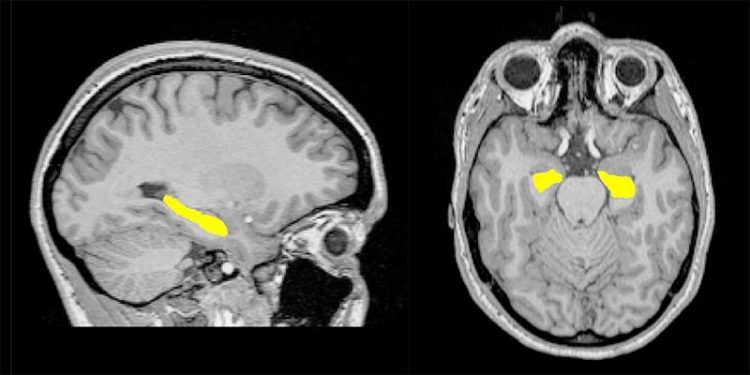In Search of Neurobiological Factors for Schizophrenia

Location of the hippocampus in the human brain: sagittal and axial view (from left to right) of the hippocampus (yellow) in an MRI. Neuropsychiarty and Brain Imaging Group, Basel
Schizophrenic psychoses are a frequently occurring group of psychiatric disorders caused by a combination of biological, social and environmental factors. These disorders are associated with changes to the brain structure: for example, the hippocampus in the temporal lobe is usually smaller in affected individuals than in healthy ones. It is not yet known whether these changes to the brain structure are a result of the disorders and their accompanying medications, or whether they are already present before the onset of symptoms.
Together with a research group from the University of Basel, Fabienne Harrisberger and Stefan Borgwardt examined the brain structures of individuals exhibiting an elevated risk of psychosis, and those of individuals experiencing the onset of psychotic symptoms for the first time.
Initially, scientists from the Adult Psychiatric Clinic of the University Psychiatric Clinics (UPK) and the Transfaculty Research Platform Molecular and Cognitive Neurosciences (MCN) observed no appreciable difference between the hippocampi of individuals at high risk and those of patients.
Next, together with scientists from the Transfaculty Research Platform, they investigated whether any known schizophrenia risk genes are associated with the hippocampus. This appears to be the case: the greater the number of risk genes a person possessed, the smaller the volume of their hippocampus – regardless of whether they were a high-risk study participant or a patient. This means that a group of risk genes is connected with a reduction in the size of a critical region of the brain before the disorder manifests itself.
Potential for differentiated therapy
This result is significant for the understanding of neurobiological factors contributing to schizophrenia. It is well-known that none of the wider risk factors (e.g. genes, environment, unfavorable social situation) can be used to predict the onset of psychosis in a specific individual. However, the discovery may be of use for the treatment of schizophrenia.
“It is quite possible that individuals with smaller hippocampi will react differently to therapy compared to those with normally developed hippocampi,” explains Prof. Stefan Borgwardt of the Neuropsychiatry and Brain Imaging Unit. Further studies to ascertain the therapeutic potential of this research are planned.
Original article
Fabienne Harrisberger, Renata Smieskova, Christian Vogler, Tobias Egli, André Schmidt, Claudia Lenz, Andor E Simon, Anita Riecher-Rössler, Andreas Papassotiropoulos, Stefan Borgwardt
Impact of polygenic schizophrenia-related risk and hippocampal volumes on the onset of psychosis
Translational Psychiatry (2016), doi: 10.1038/TP.2016.143
Further information
Prof. Dr. Stefan Borgwardt, University of Basel, Adult Psychiatric Clinic of the University Psychiatric Clinics (UPK), tel. +41 61 325 81 87, email: stefan.borgwardt@upkbs.ch
Prof. Dr. Andreas Papassotiropoulos, University of Basel, Transfaculty Research Platform Molecular and Cognitive Neurosciences, tel. +41 61 267 05 99, email: andreas.papas@unibas.ch
https://www.unibas.ch/en/News-Events/News/Uni-Research/In-Search-of-Neurobiologi…
Media Contact
All latest news from the category: Life Sciences and Chemistry
Articles and reports from the Life Sciences and chemistry area deal with applied and basic research into modern biology, chemistry and human medicine.
Valuable information can be found on a range of life sciences fields including bacteriology, biochemistry, bionics, bioinformatics, biophysics, biotechnology, genetics, geobotany, human biology, marine biology, microbiology, molecular biology, cellular biology, zoology, bioinorganic chemistry, microchemistry and environmental chemistry.
Newest articles

Properties of new materials for microchips
… can now be measured well. Reseachers of Delft University of Technology demonstrated measuring performance properties of ultrathin silicon membranes. Making ever smaller and more powerful chips requires new ultrathin…

Floating solar’s potential
… to support sustainable development by addressing climate, water, and energy goals holistically. A new study published this week in Nature Energy raises the potential for floating solar photovoltaics (FPV)…

Skyrmions move at record speeds
… a step towards the computing of the future. An international research team led by scientists from the CNRS1 has discovered that the magnetic nanobubbles2 known as skyrmions can be…





















